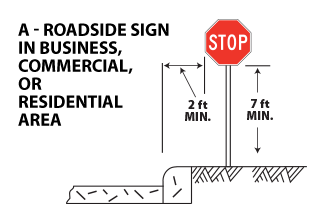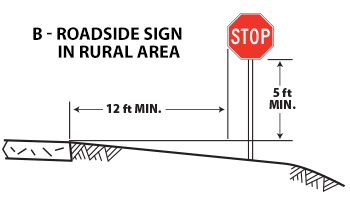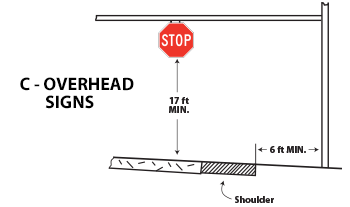MUTCD Stop Sign FAQ
1) What are the differences between the 3 types of reflectivity?
-
Illustration Application Engineering Grade Prismatic (EGP) Type I High Intensity Prismatic (HIP) Type IV Diamond Grade (DG) Type IX 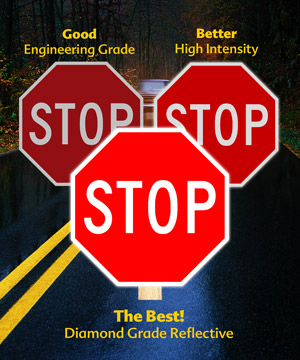
Ideal Use Great for parking lots Most common for roadways Best choice for roadways Brightness Standard High Maximum General Lifespan 7 years 10 years 10+ years Night-time visibility 500 feet away 1000 feet away 1500 feet away
2) What size sign should I choose?
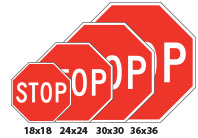
- 18 x 18" - Used for bicyclist traffic control on bikeways and shared-use paths
- 24 x 24" - Great for parking lots and private roadways
- 30 x 30" - The minimum size required for official street applications
- 36 x 36" - Minimum size for multi-lane approaches and hazardous intersections
3) What height do I need to mount my stop sign?
*Most Common Application
- In business, commercial, or residential areas (Fig. A)
- minimum height, measured vertically from the bottom of the sign to the top of the curb, or in the absence of curb, measured vertically from the bottom of the sign to the elevation of the near edge of the traveled way, of signs installed at the side of the road where the view of the sign might be obstructed, shall be 7 feet.
Signs installed above sidewalks: The minimum height, measured vertically from the bottom of the sign to the sidewalk, shall be 7 feet.
- In rural areas (Fig. B)
- The minimum height, measured vertically from the bottom of the sign to the elevation of the near edge of the pavement, shall be 5 feet.
- Overhead signs (Fig. C)
- Shall provide a vertical clearance of not less than 17 feet to the sign, light fixture, or sign bridge over the entire width of the pavement and shoulders except where the structure on which the overhead signs are to be mounted or other structures along the roadway near the sign structure have a lesser vertical clearance.
Source: MUTCD
SafetySign.com does not recommend or specify the use of a specific safety sign because it does not have knowledge of the hazard(s) our customers are identifying. It is the customer’s sole responsibility to identify the hazard(s) that may be present and select one or more signs (stock or custom) that accurately identify their specific hazard(s) and complies with any applicable federal, state or local laws or regulations, any worksite specific rules or regulations and/or any applicable safety standards (including, without limitation, MUTCD standards). SafetySign.com disclaims any and all liability (excluding liability for our Product Warranty contained in our Terms and Conditions) for any sign selected by a customer and shall not be responsible for any personal injury or property damage resulting from the use of signs purchased from it or for the independent interpretation made of any applicable federal, state or local laws or regulations, any worksite specific rules or regulations, and/or any applicable safety standards (including, without limitation, MUTCD standards). Customer shall indemnify and hold SafetySign.com and its corporate parent and its officers, directors, and affiliates harmless from and against any and all claims, loss, or expense (including attorneys’ fees) arising from or related to the purchase and use by customer or any third party of any sign purchased by customer from SafetySign.com.

